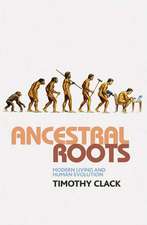A Primer in Biological Data Analysis Using R
Autor Gregg Hartvigsenen Limba Engleză Paperback – 13 mar 2014
| Toate formatele și edițiile | Preț | Express |
|---|---|---|
| Paperback (1) | 299.26 lei 6-8 săpt. | |
| Columbia University Press – 13 mar 2014 | 299.26 lei 6-8 săpt. | |
| Hardback (1) | 705.83 lei 6-8 săpt. | |
| Columbia University Press – 20 mar 2014 | 705.83 lei 6-8 săpt. |
Preț: 299.26 lei
Nou
Puncte Express: 449
Preț estimativ în valută:
57.27€ • 60.06$ • 47.67£
57.27€ • 60.06$ • 47.67£
Carte tipărită la comandă
Livrare economică 01-15 aprilie
Preluare comenzi: 021 569.72.76
Specificații
ISBN-13: 9780231166997
ISBN-10: 0231166990
Pagini: 224
Ilustrații: black & white illustrations, figures
Dimensiuni: 177 x 253 x 14 mm
Greutate: 0.45 kg
Editura: Columbia University Press
ISBN-10: 0231166990
Pagini: 224
Ilustrații: black & white illustrations, figures
Dimensiuni: 177 x 253 x 14 mm
Greutate: 0.45 kg
Editura: Columbia University Press
Notă biografică
Gregg Hartvigsen is a professor in the Department of Biology at the State University of New York at Geneseo. He taught a workshop on network analysis using R at the National Institute for Mathematical and Biological Synthesis at the University of Tennessee, Knoxville, and was a visiting scientist and site reviewer for the Mathematical Biosciences Institute at Ohio State University. He also served as co-PI on a National Science Foundation training grant for undergraduate biology and mathematics.
Cuprins
Introduction
1. Introducing Our Software Team
1.1. Solving Problems with Excel and R
1.2. Install R and RStudio
1.3. Getting Help with R
1.4. R as a Graphing Calculator
1.5. Using Script Files
1.6. Extensibility
1.7. Problems
2. Getting Data Into R
2.1. Using C( ) for Small Datasets
2.2. Reading Data from an Excel Spreadsheet
2.3. Reading Data from a Website
2.4. Problems
3. Working with Your Data
3.1. Accuracy and Precision of Our Data
3.2. Collecting Data Into Dataframes
3.3. Stacking Data
3.4. Subsetting Data
3.5. Sampling Data
3.6. Sorting an Array of Data
3.7. Ordering Data
3.8. Sorting a Dataframe
3.9. Saving a Dataframe to a File
3.10. Problems
4. Tell Me About My Data
4.1. What Are Data?
4.2. Where's the Middle?
4.3. Dispersion About the Middle
4.4. Testing for Normality
4.5. Outliers
4.6. Dealing with Non-normal Data
4.7. Problems
5. Visualizing Your Data
5.1. Overview
5.2. Histograms
5.3. Boxplots
5.4. Barplots
5.5. Scatterplots
5.6. Bump Charts (Before and After Line Plots)
5.7. Pie Charts
5.8. Multiple Graphs (Using Par and Pairs)
5.9. Problems
6. The Interpretation of Hypothesis Tests
6.1. What Do We Mean by "Statistics"?
6.2. How to Ask and Answer Scientific Questions
6.3. The Difference Between "Hypothesis" and "Theory"
6.4. A Few Experimental Design Principles
6.5. How to Set Up a Simple Random Sample for an Experiment
6.6. Interpreting Results: What is the "P-value"?
6.7. Type I and Type II Errors
6.8. Problems
7. Hypothesis Tests: One- and Two-Sample Comparisons
7.1. Tests with One Value and One Sample
7.2. Tests with Paired Samples (Not Independent)
7.3. Tests with Two Independent Samples
7.4. Problems
8. Testing Differences Among Multiple Samples
8.1. Samples Are Normally Distributed
8.2. One-way Test for Non-parametric Data
8.3. Two-way Analysis of Variance
8.4. Problems
9. Hypothesis Tests: Linear Relationships
9.1. Correlation
9.2. Linear Regression
9.3. Problems
10. Hypothesis Tests: Observed and Expected Values
10.1. The X2 Test
10.2. The Fisher Exact Test
10.3. Problems
11. A Few More Advanced Procedures
11.1. Writing Your Own Function
11.2. Adding 95% Confidence Intervals to Barplots
11.3. Adding Letters to Barplots
11.4. Adding 95% Confidence Interval Lines for Linear Regression
11.5. Non-linear Regression
11.6. An Introduction to Mathematical Modeling
11.7. Problems
12. An Introduction to Computer Programming
12.1. What Is a "Computer Program"?
12.2. Introducing Algorithms
12.3. Combining Programming and Computer Output
12.4. Problems
13. Final Thoughts
13.1. Where Do I Go from Here?
Acknowledgments
Solutions to Odd-Numbered Problems
Bibliography
Index
1. Introducing Our Software Team
1.1. Solving Problems with Excel and R
1.2. Install R and RStudio
1.3. Getting Help with R
1.4. R as a Graphing Calculator
1.5. Using Script Files
1.6. Extensibility
1.7. Problems
2. Getting Data Into R
2.1. Using C( ) for Small Datasets
2.2. Reading Data from an Excel Spreadsheet
2.3. Reading Data from a Website
2.4. Problems
3. Working with Your Data
3.1. Accuracy and Precision of Our Data
3.2. Collecting Data Into Dataframes
3.3. Stacking Data
3.4. Subsetting Data
3.5. Sampling Data
3.6. Sorting an Array of Data
3.7. Ordering Data
3.8. Sorting a Dataframe
3.9. Saving a Dataframe to a File
3.10. Problems
4. Tell Me About My Data
4.1. What Are Data?
4.2. Where's the Middle?
4.3. Dispersion About the Middle
4.4. Testing for Normality
4.5. Outliers
4.6. Dealing with Non-normal Data
4.7. Problems
5. Visualizing Your Data
5.1. Overview
5.2. Histograms
5.3. Boxplots
5.4. Barplots
5.5. Scatterplots
5.6. Bump Charts (Before and After Line Plots)
5.7. Pie Charts
5.8. Multiple Graphs (Using Par and Pairs)
5.9. Problems
6. The Interpretation of Hypothesis Tests
6.1. What Do We Mean by "Statistics"?
6.2. How to Ask and Answer Scientific Questions
6.3. The Difference Between "Hypothesis" and "Theory"
6.4. A Few Experimental Design Principles
6.5. How to Set Up a Simple Random Sample for an Experiment
6.6. Interpreting Results: What is the "P-value"?
6.7. Type I and Type II Errors
6.8. Problems
7. Hypothesis Tests: One- and Two-Sample Comparisons
7.1. Tests with One Value and One Sample
7.2. Tests with Paired Samples (Not Independent)
7.3. Tests with Two Independent Samples
7.4. Problems
8. Testing Differences Among Multiple Samples
8.1. Samples Are Normally Distributed
8.2. One-way Test for Non-parametric Data
8.3. Two-way Analysis of Variance
8.4. Problems
9. Hypothesis Tests: Linear Relationships
9.1. Correlation
9.2. Linear Regression
9.3. Problems
10. Hypothesis Tests: Observed and Expected Values
10.1. The X2 Test
10.2. The Fisher Exact Test
10.3. Problems
11. A Few More Advanced Procedures
11.1. Writing Your Own Function
11.2. Adding 95% Confidence Intervals to Barplots
11.3. Adding Letters to Barplots
11.4. Adding 95% Confidence Interval Lines for Linear Regression
11.5. Non-linear Regression
11.6. An Introduction to Mathematical Modeling
11.7. Problems
12. An Introduction to Computer Programming
12.1. What Is a "Computer Program"?
12.2. Introducing Algorithms
12.3. Combining Programming and Computer Output
12.4. Problems
13. Final Thoughts
13.1. Where Do I Go from Here?
Acknowledgments
Solutions to Odd-Numbered Problems
Bibliography
Index
Descriere
Descriere de la o altă ediție sau format:
Drawing on Gregg Hartvigsen’s extensive experience teaching biostatistics and modeling biological systems, this text is an engaging, practical, and lab-oriented introduction to R for students in the life sciences.
Drawing on Gregg Hartvigsen’s extensive experience teaching biostatistics and modeling biological systems, this text is an engaging, practical, and lab-oriented introduction to R for students in the life sciences.













